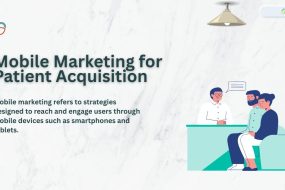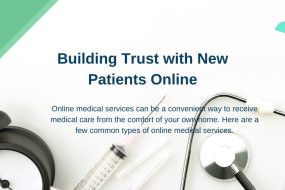
Healthcare providers face an increasingly competitive landscape where traditional referral methods alone fall short of sustaining practice growth. Modern patients research providers online, compare reviews, and expect seamless digital experiences before choosing where to receive care.
Successful patient acquisition requires a strategic combination of digital marketing, exceptional patient experiences, and community engagement. This comprehensive guide explores proven strategies that help healthcare practices build sustainable systems for attracting and retaining patients.
Digital Marketing Strategies for Healthcare Growth
Search Engine Optimization for Healthcare Practices
Most patients begin their healthcare journey with an online search. When someone searches for “cardiologist near me” or “pediatric dentist,” your practice should appear prominently in search results.
Effective SEO for patient acquisition starts with local optimization. Claim and optimize your Google Business Profile with accurate contact information, hours, and services. This free tool acts as your digital storefront, displaying essential information when patients search for healthcare providers in your area.
Patient reviews significantly impact local search rankings and patient decision-making. Encourage satisfied patients to leave reviews by sending follow-up emails after appointments or including review requests in your patient communication materials. Respond professionally to all reviews, both positive and negative, to demonstrate your commitment to patient care.
Create valuable content that addresses common patient questions. Blog posts about symptoms, treatment options, and preventive care establish your expertise while helping patients find answers. Focus on long-tail keywords that reflect how patients actually search, such as “signs I need to see an orthopedist” rather than generic terms like “orthopedic care.”
Local SEO elements matter significantly for healthcare websites. Ensure your website loads quickly, works well on mobile devices, and has clear navigation. Patients who struggle to find information or book appointments online will likely choose competitors with better user experiences.
Social Media Marketing for Patient Engagement

Social media platforms offer direct connections with potential patients and opportunities to build trust through educational content.
Facebook remains particularly valuable for healthcare practices, as many patients use it to research providers and read reviews. Share educational content that demonstrates your expertise without violating patient privacy. Post about seasonal health tips, new treatment options, or behind-the-scenes glimpses of your practice culture.
Video content performs especially well on social media. Consider creating short videos explaining common procedures, introducing staff members, or addressing frequently asked questions. These videos humanize your practice and help patients feel more comfortable before their first visit.
Instagram works well for practices with visual elements, such as dermatology, plastic surgery, or dental practices. Before-and-after photos (with proper patient consent) and infographics about health topics can attract engaged followers.
LinkedIn helps build professional relationships and can be valuable for specialized practices targeting other healthcare providers or corporate wellness programs.
Pay-Per-Click Advertising in Healthcare
PPC advertising provides immediate visibility for healthcare practices. Google Ads can place your practice at the top of search results for relevant keywords, while Facebook and Instagram ads help target specific demographics.
Healthcare PPC requires careful attention to compliance regulations. Avoid making unrealistic claims about treatment outcomes, and ensure all ad content meets medical advertising guidelines in your jurisdiction.
Target local keywords with commercial intent, such as “emergency dentist [city name]” or “book dermatologist appointment.” Use ad extensions to include phone numbers, location information, and links to specific services.
Monitor your campaigns closely and adjust based on performance data. Track which keywords generate the most qualified leads and allocate budget accordingly. Consider the lifetime value of patients when evaluating campaign ROI, as healthcare relationships often span years.
Patient Experience and Retention Strategies
Optimizing the Patient Journey
Patient acquisition isn’t just about attracting new patients—it’s about creating experiences that encourage long-term relationships and referrals.
Map out every touchpoint in your patient journey, from initial online research to post-treatment follow-up. Identify potential friction points and opportunities for improvement. Common areas for optimization include:
Online Booking Systems: Implement user-friendly scheduling systems that allow patients to book appointments 24/7. Reduce barriers by minimizing required information and offering multiple time slots.
Communication Protocols: Establish clear communication standards for appointment confirmations, reminders, and follow-up care. Use automated systems to ensure consistency while maintaining personal touches.
Wait Times: Minimize wait times through efficient scheduling practices and keep patients informed about any delays. Consider offering virtual check-in options to reduce crowding in waiting areas.
Staff Training: Ensure all staff members understand their role in creating positive patient experiences. Front-desk interactions often form patients’ first impressions of your practice.
Click here for knowing about which one is best : Patient Acquisition vs Patient Retention
Building Patient Loyalty Programs
Loyalty programs can increase patient retention and encourage referrals. Consider implementing:
Referral Incentives: Offer rewards for patients who refer family members or friends to your practice. This could include discounts on future services, gift cards, or priority scheduling.
Preventive Care Rewards: Encourage regular check-ups and preventive care through rewards programs. This improves patient health outcomes while maintaining steady appointment volumes.
Family Discounts: Provide discounts for families who receive multiple services at your practice. This approach works particularly well for dental practices, pediatric offices, and family medicine practices.
Read our latest blog How to Attract New Patients to Your Clinic
Community Engagement and Partnerships
Local Healthcare Partnerships
Building relationships with other healthcare providers creates valuable referral networks. Establish partnerships with:
Complementary Specialties: Connect with specialists who serve your patient population. For example, primary care physicians can partner with cardiologists, endocrinologists, and mental health professionals.
Local Hospitals: Maintain relationships with local hospitals and urgent care centers. These partnerships can provide referrals for follow-up care and specialized services.
Healthcare Networks: Join professional associations and local medical societies to network with other providers and stay current on industry trends.
Community Outreach Programs
Active community involvement builds brand awareness and demonstrates your commitment to public health.
Health Screenings: Offer free or low-cost health screenings at community events, schools, or workplace health fairs. These events provide valuable health services while introducing your practice to potential patients.
Educational Workshops: Host workshops on topics relevant to your specialty. Topics might include nutrition education, exercise programs, or disease prevention strategies.
Sponsorship Opportunities: Sponsor local events, sports teams, or health-related causes. This builds positive brand associations while supporting your community.
Technology Integration for Patient Acquisition

Telemedicine and Virtual Care
Telemedicine capabilities have become essential for modern healthcare practices. Virtual consultations can:
Expand Your Geographic Reach: Serve patients who live far from your practice or have mobility limitations.
Offer Convenient Follow-up Care: Provide efficient follow-up appointments that don’t require travel time for patients.
Attract Tech-Savvy Patients: Appeal to patients who value convenience and modern healthcare delivery methods.
Patient Communication Systems
Implement comprehensive communication systems that keep patients engaged throughout their care journey.
Automated Appointment Reminders: Reduce no-shows through text messages, emails, or phone call reminders.
Educational Content Delivery: Send targeted health information based on patients’ conditions or interests.
Care Coordination: Use secure messaging systems to coordinate care between appointments and answer non-urgent questions.
Measuring Patient Acquisition Success
Key Performance Indicators
Track specific metrics to evaluate your patient acquisition efforts:
New Patient Volume: Monitor monthly new patient numbers and identify trends or seasonal patterns.
Patient Lifetime Value: Calculate the total revenue generated by patients over their relationship with your practice.
Referral Rates: Track how many new patients come from existing patient referrals versus other sources.
Digital Marketing ROI: Measure the return on investment for various marketing channels to optimize budget allocation.
Continuous Improvement Strategies
Regularly review and refine your patient acquisition strategies based on performance data and patient feedback.
Patient Surveys: Conduct regular surveys to understand patient satisfaction and identify areas for improvement.
A/B Testing: Test different approaches to marketing messages, website designs, and patient communication to optimize results.
Competitor Analysis: Monitor competitor activities and patient reviews to identify opportunities for differentiation.
Building Sustainable Growth Through Patient Acquisition
Successful patient acquisition requires a comprehensive approach that combines digital marketing, exceptional patient experiences, and community engagement. The most effective strategies focus on building long-term relationships rather than just attracting one-time patients.
Start by implementing one or two strategies that align with your practice’s strengths and patient population. As you see results, gradually expand your efforts to include additional tactics. Remember that patient acquisition is an ongoing process that requires consistent effort and continuous refinement.
The healthcare landscape will continue evolving, but practices that prioritize patient needs, embrace technology, and maintain strong community connections will thrive. Focus on creating value for patients at every touchpoint, and your practice will build a sustainable foundation for long-term growth.


















No Comments